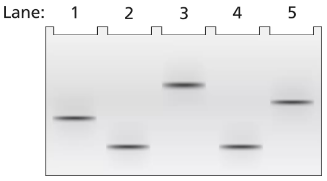It can be said that modern biology is experiencing an 'omics' revolution. What does this mean? Explain your answer.
Table of contents
- 1. Introduction to Genetics51m
- 2. Mendel's Laws of Inheritance3h 37m
- 3. Extensions to Mendelian Inheritance2h 41m
- 4. Genetic Mapping and Linkage2h 28m
- 5. Genetics of Bacteria and Viruses1h 21m
- 6. Chromosomal Variation1h 48m
- 7. DNA and Chromosome Structure56m
- 8. DNA Replication1h 10m
- 9. Mitosis and Meiosis1h 34m
- 10. Transcription1h 0m
- 11. Translation58m
- 12. Gene Regulation in Prokaryotes1h 19m
- 13. Gene Regulation in Eukaryotes44m
- 14. Genetic Control of Development44m
- 15. Genomes and Genomics1h 50m
- 16. Transposable Elements47m
- 17. Mutation, Repair, and Recombination1h 6m
- 18. Molecular Genetic Tools19m
- 19. Cancer Genetics29m
- 20. Quantitative Genetics1h 26m
- 21. Population Genetics50m
- 22. Evolutionary Genetics29m
15. Genomes and Genomics
Functional Genomics
Problem 18a
Textbook Question
A 3.5-kb segment of DNA containing the complete sequence of a mouse gene is available. The DNA segment contains the promoter sequence and extends beyond the polyadenylation site of the gene. The DNA is studied by band shift assay, and the following gel bands are observed.

Match these conditions to a specific lane of the gel.
3.5-kb fragment plus TFIIB and TFIID
 Verified step by step guidance
Verified step by step guidance1
Examine the gel image provided. Each lane represents a different experimental condition, and the bands indicate the presence of DNA-protein complexes or free DNA.
Understand the role of TFIIB and TFIID. These are transcription factors that bind to the promoter region of DNA, forming a complex that can be detected in a band shift assay.
Compare the lanes in the gel. Lane 1 likely represents the control condition with the 3.5-kb DNA fragment alone, showing a single band corresponding to free DNA.
Identify the lanes where TFIIB and TFIID are added. The addition of these transcription factors should result in a shifted band (higher up in the gel) due to the formation of DNA-protein complexes.
Match the observed band shifts in the gel to the experimental condition described (3.5-kb fragment plus TFIIB and TFIID). The lane with the shifted band indicates the presence of the DNA-protein complex formed by TFIIB and TFIID binding to the promoter region.
 Verified video answer for a similar problem:
Verified video answer for a similar problem:This video solution was recommended by our tutors as helpful for the problem above
Video duration:
1mPlay a video:
Was this helpful?
Key Concepts
Here are the essential concepts you must grasp in order to answer the question correctly.
Promoter Sequence
The promoter sequence is a region of DNA located upstream of a gene that initiates transcription. It contains specific binding sites for transcription factors and RNA polymerase, which are essential for the transcription process. Understanding the promoter's role is crucial for analyzing gene expression and the effects of regulatory proteins.
Recommended video:
Guided course

Sequencing Difficulties
Transcription Factors (TFIIB and TFIID)
Transcription factors are proteins that bind to specific DNA sequences to regulate gene expression. TFIIB and TFIID are essential components of the transcription initiation complex. TFIID recognizes the promoter region and recruits TFIIB, which helps position RNA polymerase at the start site of transcription, making them vital for understanding gene regulation.
Recommended video:
Guided course

Eukaryotic Transcription
Gel Electrophoresis
Gel electrophoresis is a laboratory technique used to separate DNA, RNA, or proteins based on their size and charge. In this context, it helps visualize the binding of transcription factors to the DNA segment. The resulting gel bands indicate the presence and size of DNA-protein complexes, providing insights into the interactions between the gene and transcription factors.
Recommended video:
Guided course

Proteomics
Related Videos
Related Practice
Textbook Question
494
views


